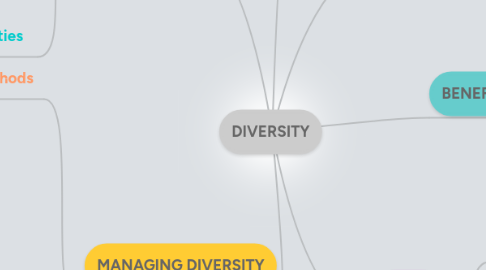
1. BARRIERS
1.1. General Barriers
1.1.1. Organisational Culture and Inertia
1.1.2. Lack of support from Top Management
1.1.3. Insufficient Staffs
1.1.4. Viewpoint towards Diversity
1.1.5. Organisational Complexity
1.1.6. Time Constraints
1.1.7. Resistance to Change
1.2. Faced by Minorities
1.2.1. Oppression Models
1.2.2. Communication Barriers
1.2.2.1. Stereotypes
1.2.2.2. Perceptions
1.2.2.3. Bias
2. MANAGING DIVERSITY
2.1. Methods
2.1.1. Develop Diversity Practices
2.1.1.1. Promote Diversity in Leadership positions
2.1.2. Bridging Diversity
2.1.3. Empathy
2.1.4. Respect
2.1.5. Fostering Organisational Attitude
2.1.6. Ward off Change resistance
2.2. Process
2.2.1. STEP 1 Assestment of Diversity
2.2.2. STEP 2 Develop an effective Strategy
2.2.2.1. 1. Communicating with employees
2.2.2.2. 2. Assigning responsibility
2.2.2.3. 3. Allocating financial resources
2.2.2.4. 4. Establishing a diversity council/task force
2.2.2.5. 5. Building accountability
2.2.3. STEP 3 Implement an Action Plan
2.2.3.1. 1. Communicating the action plan
2.2.3.2. 2. Conducting the initial diversity assessment
2.2.3.3. 3. Setting diversity business goals
2.2.3.4. 4. Providing employee training and development
2.2.4. STEP 4 Evaluate Strategy
3. BENEFITS
3.1. Communication Issues
3.2. Learning & Growth
3.3. Increased Adaptability
3.4. Variety of Viewpoints
3.5. Diverse Experience
3.6. Globalisation
4. TYPES
4.1. Primary Characteristics
4.1.1. Age
4.1.2. Gender
4.1.3. Sexual Orientation
4.1.4. Race
4.1.5. Disabilities
4.2. Secondary Characteristics
4.2.1. Culture
4.2.2. Socio Economic Status
4.2.3. Personality Characteristics
